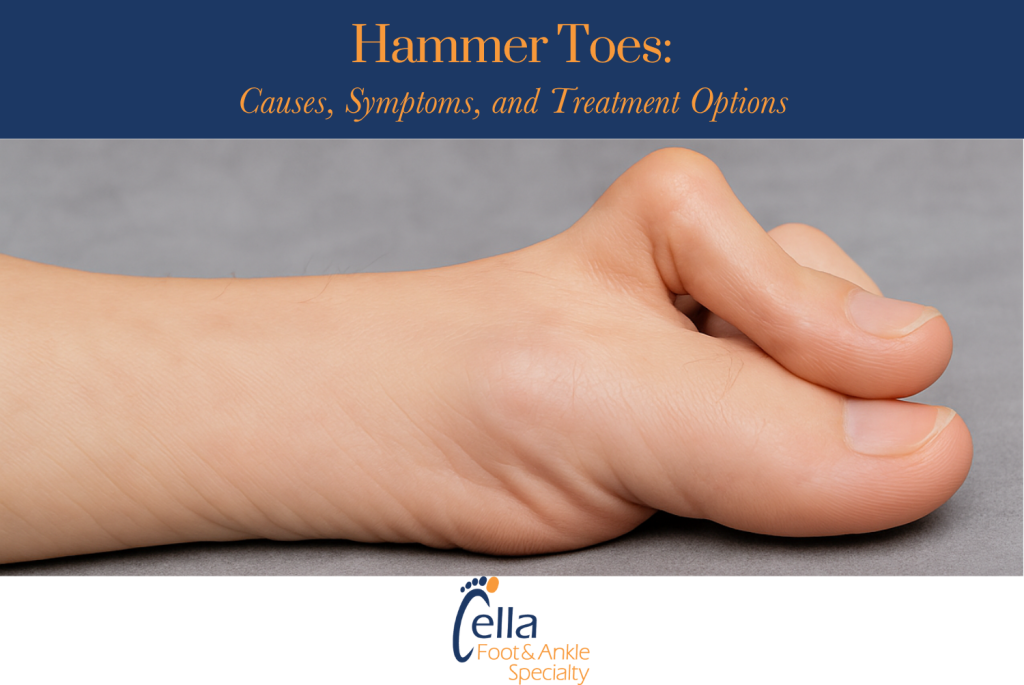
What Are Hammer Toes?
Hammer toes are a common but often painful deformity that affects the smaller toes, typically the second, third, or fourth. The condition causes one or more toes to bend downward at the middle joint, resembling the shape of a hammer. Over time, this abnormal bending can lead to stiffness, corns, calluses, and difficulty wearing shoes comfortably.
While hammer toes can develop at any age, they’re most often seen in adults due to years of repetitive stress, improper footwear, or muscle imbalances in the foot.
Common Causes of Hammer Toes
Several factors can contribute to the development of hammer toes, including:
- Improper Footwear – Tight, narrow, or high-heeled shoes can crowd the toes and force them into a bent position.
- Muscle or Tendon Imbalance – When the muscles that control the toes are not balanced, one muscle may overpower another, pulling the toe into an abnormal position.
- Trauma or Injury – A stubbed, jammed, or broken toe can sometimes heal in a bent position.
- Genetics – A family history of foot deformities or flat feet increases risk.
- Underlying Conditions – Arthritis, diabetes, and neuromuscular disorders can make individuals more prone to developing toe deformities.
Symptoms of Hammer Toes
Hammer toe symptoms often start mild but can worsen over time if left untreated. Common signs include:
- A visible bend in the middle joint of one or more toes
- Pain or irritation when wearing shoes
- Corns and calluses from friction
- Redness, inflammation, or swelling around the affected joint
- Limited motion or stiffness in the toe joint
If pain persists or walking becomes uncomfortable, it’s important to seek professional evaluation early.
Treatment Options at Cella Foot & Ankle Specialty
Dr. Cella and the team at Cella Foot & Ankle Specialty offer comprehensive evaluation and treatment for hammer toes, ranging from conservative therapies to advanced surgical correction. Treatment options include:
Non-Surgical Treatments
- Proper Footwear: Wearing shoes with a wider toe box and low heels to reduce pressure.
- Custom Orthotics: Devices designed to correct underlying imbalances and provide arch support.
- Padding and Taping: Helps realign the toe and relieve pressure points.
- Physical Therapy: Strengthening and stretching exercises to restore flexibility.
- Anti-Inflammatory Medications: Reduce pain and swelling.
Surgical Treatments
For severe or rigid hammer toes, surgical intervention may be necessary. Options include:
- Tendon Release or Transfer – Releasing or repositioning tendons to restore proper alignment.
- Joint Resection or Fusion – Removing part of the joint or fusing bones to straighten the toe.
- Minimally Invasive Surgery (MIS) – Small incisions and precision techniques that allow faster recovery and minimal scarring.
Dr. Cella is highly experienced in minimally invasive foot surgery, which can correct deformities with reduced downtime and improved cosmetic results.
Recovery and Prevention
Recovery time depends on the severity of the deformity and the type of treatment performed. Non-surgical approaches often yield improvement within weeks, while surgical correction may require several weeks of rest and physical therapy.
To prevent hammer toes:
- Choose shoes with proper arch support and roomy toe boxes.
- Avoid prolonged use of high heels.
- Perform regular toe-stretching exercises.
- Address foot pain early before it progresses to a deformity.
Hammer Toe Q&A
Q: Can hammer toes go away on their own?
A: No. Once the toe becomes bent, it won’t return to normal without treatment. Early intervention can, however, prevent it from getting worse.
Q: Is hammer toe surgery painful?
A: Modern surgical techniques, especially minimally invasive ones, minimize discomfort and allow for faster healing with minimal scarring.
Q: How do I know if I need surgery?
A: If conservative treatments like orthotics, footwear changes, and physical therapy don’t relieve your symptoms—or if your toe becomes rigid and painful—Dr. Cella may recommend surgical correction.
Q: Can hammer toes come back after surgery?
A: Recurrence is rare when the underlying cause (like footwear or muscle imbalance) is addressed. Following post-operative care instructions is key to maintaining long-term results.
Q: Are hammer toes linked to other foot problems?
A: Yes. Hammer toes often occur alongside bunions, flat feet, or calluses, especially when caused by biomechanical imbalances.
Q: Can children develop hammer toes?
A: It’s uncommon but possible, particularly if there’s a genetic predisposition or neuromuscular issue.
Contact Cella Foot & Ankle Specialty
If you’re struggling with pain or stiffness in your toes, don’t wait until it affects your mobility. The team at Cella Foot & Ankle Specialty can help you regain comfort and function through customized care plans tailored to your needs.
Cella Foot & Ankle Specialty
📍 19–21 Fair Lawn Avenue, Suite 2A, Fair Lawn, NJ 07410
📞 (201) 773-6557
🌐 cellafas.com
